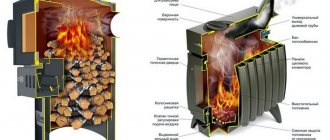Electricity can be generated using new technologies, which include solar panels and wind power plants, and by using methods that have been known for several decades. Devices for generating energy include a gas generating unit. The device can be the main source of electricity and a backup one, designed to support the operation of household equipment during temporary power outages. Gas generators are used to generate electricity and for space heating. Highly efficient equipment is an acceptable alternative for heating private homes in the absence of natural gas.
Factory model of a wood-burning gas generator
Operating principle and features
One of the main questions that arises for a person who has not encountered a wood-burning gas generator is what is the operating principle of the equipment and what is it needed for. Using such a device to produce gas allows you to solve several problems:
- create a backup power supply system for a private home;
- obtain comfortable microclimatic conditions during the heating season and simultaneously obtain gas for other purposes (for example, cooking);
- ensure the operation of the internal combustion engine of the car.
Homemade gas generator
By heating solid fuel to 1100 °C and limiting the access of oxygen to its combustion zone, you can make the equipment pyrolysis. The basic principle of operation of the gas generator is to convert the cellulose contained in wood into olefins (propylene and ethylene) using the pyrolysis process. The resulting gases are cleaned by a filter system from soot, ash and other impurities, and then cooled. After cooling, the products end up in the secondary combustion chamber, where they continue to burn, heating the walls of the boiler. To improve the combustion process, air is supplied to the same firebox. The technical aspects are described in detail in the video below.
The efficiency of pyrolysis boilers is higher compared to conventional wood-burning stoves and boilers, and the time and money spent on creating a homemade gas generator will pay off in the future. Moreover, a wood-burning gas generator can be made not only as heating equipment, but also as water heating equipment. To do this, the walls of the boiler, which heat up during the combustion of wood, are connected to a heat exchanger.
Pyrolysis boiler (gas generator) with indirect heating boiler
Criterias of choice
Due to the fact that the wood-burning autonomous electric generator exists in several versions, the user’s choice is simplified. Since only a generator stove is suitable for the home, there are no other options. And large wood-burning power plants are used to supply power to industrial or civil facilities, since their power varies between 100-200 kW.
When choosing, you should take into account the size of the facility that will be served, as well as what power you should expect. To determine the amount of fuel consumption, you need to plan with what degree of efficiency and how often the device will be used, based on this, the volume of the loading container for firewood is selected.
Existing models
Fully functional, high-performance equipment such as the BioKIBOR power plant is quite expensive. If a wood-burning generator was chosen for the facility, then you can buy it within the amount of 2,000,000 rubles. By design, this is a modular installation with automatic fuel supply. To provide 100 kW equipment with firewood for one day, 5 tons (or 200 kg per hour of operation) will be required. The specified amount of fuel is required for full operation of the station.
Let's watch a video about the Indigirka wood-burning stove-generator model:
A device such as a wood-burning stove-generator (Indigirka brand Termofor) will cost the user approximately 30,000 rubles. When purchasing, the capacity of the combustion chamber is taken into account (41 liters), with a maximum load of 30 liters. To remove combustion products, a chimney is provided, the diameter of which is 80 mm and the height is 3 m. The output voltage is 12 V and the power is 60 W.
General recommendations
Wood-burning generator for charging your phone
To maintain a high temperature, it is necessary to ensure that there is enough fuel in the combustion chamber. If this is not necessary in the case of an automated power plant, then the furnace-generator does not have the function of autonomous fuel supply.
Such a device must be operated with a chimney that removes combustion products, especially if the operation is carried out indoors.
As an alternative to expensive equipment, you can make a backup electric generator using wood with your own hands. But this design also implies the use of a Peltier element. Without this, it is problematic to organize the conversion of temperature into electricity. According to users, a compact stove-generator is fully justified, especially in the context of the current decline in the price of such a unit and the availability of solid fuel.
Thus, the operation of a low-power household electric generator is an alternative to high-performance gasoline and diesel devices. But before purchasing, you should consider such a thing as the need to purchase an inverter to convert the output voltage of 12 V to 220 V. Without this, it will be impossible to connect most modern devices.
Pros and cons of using wood-burning gas generators
Among the advantages of using gas generators it is worth noting:
- Effective use of wood waste - sawdust, trimmings and chips. Typically, such materials are classified as garbage and thrown away - the generator receives heat and gas from them.
- High efficiency of the gas generator, depending on the methods of calorie counting, reaching 80–95%. For budget wood boilers, the coefficient rarely exceeds 70%.
- Possibility of use in places remote from large populated areas and without gas or electricity supply.
- The installation is environmentally friendly compared to liquid fuel boilers, which not only emit more harmful substances into the air, but also require the creation of special tanks for storing fuel.
The widespread use of wood-burning gas generators is hampered by several disadvantages, the main one of which is the large dimensions of the device. The video below shows a gas generator used in the heating process of a metalworking workshop with an area of 1200 m².
Based on the words of the author of the video (see below), when using a gasgen, the efficiency of the heating system increased by 33%, but it is not said what the cost of electricity consumed by the fan is.
In addition, during operation, the equipment requires constant cleaning - the centrifuge, furnace and cooling elements are regularly cleaned. The disadvantages also include the need to periodically replace “consumables” (filters for the gas produced by the installation) and use only wood with a moisture content of up to 20%.
Firewood requires storage space, and gas begins to form only 20–30 minutes after the start of combustion. When using a gas generator for a private home, you should not pay attention to the last two disadvantages, but for a car these disadvantages are critical. It is almost impossible to regulate the temperature in the firebox, and the walls of the chamber become very hot, so the equipment has a shorter service life compared to wood-burning stoves and boilers used for heating.
Serial automobile gas generator
Installation Rules
When installing gas generating units using wood, it is recommended to follow the following rules:
- Installation of equipment is allowed anywhere in the house - basement, basement, room - as well as outdoors, subject to safety precautions and technical conditions.
- Models designed for loading long firewood are best installed outdoors near the fuel storage area.
- For installation inside the house, it is better to choose a generator that runs on pellets. Since their storage and operation does not involve the generation of waste.
- In the case of using flue gases for heating and minimal cooling, pipes to the house from a unit installed on the street are laid in thermal insulation and underground.
Recommendation! Gas generators exhibit maximum performance when fully loaded. However, the amount of energy generated can be excessive. Therefore, in order to preserve it, for example, for heating, it is necessary to use special heat-insulated containers - heat accumulators.
Manufacturing a wood-burning gas generator for a private home
An important nuance that should be taken into account when creating a wood-burning gas generator with your own hands is the equipment diagram. It indicates not only the elements, but also the directions of movement of air and gas flows. You can find different options for gas generators on the Internet, and one of the most popular among domestic homeowners is a device assembled on the basis of a 200-liter metal barrel.
Schematic diagram of one of the wood-burning gas generators
A wood hopper is installed in the upper part of the cylindrical body, the volume of which is taken to be approximately 60–70 liters. A zigzag pipe is usually used as a generator filter element. You can also take the body of a fire extinguisher for this. The filter is equipped with a tap that allows you to collect and remove condensate that appears when raw wood is burned.
Homemade wood gas generator
The principle of operation of a wood-burning gas generator, the device and drawing of which are used to create a home-made device, is as follows:
- the firewood placed in the bunker ends up in the firebox and burns;
- during the combustion process, gas is formed, which enters the skirt in the upper part through a coarse cleaning system;
- When passing through the cooling filter, the gas cools down and is discharged through a special pipe (for example, to the internal combustion engine or into an additional combustion zone).
When wet wood burns, gas enters the “skirt” and upon contact with cold air leaves a small amount of water. The liquid passes through a separator made of a pipe with a ribbed plate inserted inside and is drained out. To increase the efficiency of the boiler, the purified gaseous fuel obtained from burning wood is used for additional heating, entering the second combustion zone. In this case, only carbon dioxide (CO₂) comes out.
The video below shows a version of a gasgen for heating made of sheet metal.
When creating gasgen with your own hands, you can include a boiler in the design. The water is heated by the return combustible gas, which is further cooled during this process. On average, such equipment provides heating of 5–10 liters of water per minute by 20–30 degrees.
Features of installation and use
The location for the equipment is selected taking into account the odorlessness of the gas produced and its danger to the human body . Therefore, it is advisable to install homemade wood-burning gas generators in separate rooms. The room must meet the same requirements as the boiler room - have good forced ventilation and a volume of at least 15 cubic meters.
To remove gas, a special gas pipe is used, secured with clamps to the generator pipe. The installation must have a base made of fireproof materials. It is also worth noting that the work on assembling the gas generator must be carried out by a professional - if there is no experience in carrying out such work, it is better to refuse making a homemade device for producing gas or increasing the efficiency of wood combustion.
How it works?
A standard Peltier element is a plate with two outputs for connecting to the network, assembled from cubes of different metals, for example copper and constantan, copper and nickel, lead and constantan, etc.
The plate passes electric current through itself and heats up on one side, and on the other hand it becomes cold.
The presented electric generator uses the opposite principle: one side of the element is heated by burning fuel (in this case, wood chips and firewood), the other is cooled by any heat exchanger - liquid or air, and a constant electric current is generated on the wires, which can already be used at your discretion.
One cannot expect high power levels; even in factory furnace-generators (they usually have two elements), up to 60 W are generated. Homemade ones typically output 5 W (enough to charge a cell phone or power an LED flashlight).
The electric current in such a stove is only a by-product; the main energy from the combustion of wood is not wasted, but is used to heat the room (enough for a small house, cottage or tent).
Automotive gas generator
The difference between a gas generator for a vehicle is its compactness and increased reliability - although even such characteristics do not allow the car to be driven at high speed. However, acceleration to 80–90 km/h is quite possible. The material used to manufacture a car gas generator is most often metal containers. Serial production involves the use of stainless steel, which reduces the weight of the generator and improves aesthetic parameters. Handicraft production of such devices leads to efficient, but not very neat-looking and heavy wood-burning stoves, the gas from which is transferred to the gas engine of the car.
Niva car powered by a gas generator
An old propane tank can be a good option for creating a gas fuel generator for a small car. For the internal part of the device circuit, the use of a receiver from a 20 or 40 liter truck is used. Thin metal is chosen for the grate, and ordinary heating pipes are used for the pipes.
Grate of an automobile gas generator
The lid with fasteners is made from the top of the cylinder or sheet steel. It is sealed using an asbestos cord treated with graphite impregnation. A coarse filter is made from an old fire extinguisher or a piece of pipe of similar length. A cone-shaped nozzle is installed at the bottom of the filter element through which ash will be discharged. The top of the pipe or fire extinguisher is covered with a lid with a pipe built into it.
Gas generator with filter
The presence of coolers, which are often used as bimetallic heating radiators, is required for two reasons:
- too hot gas has a low density and cannot ensure efficient operation of the internal combustion engine;
- When hot gas comes into contact with heated engine components, a flash may occur.
Another important design element is the mixer, which allows you to adjust the proportions of the gas-air mixture. If you do not change the fuel concentration, the engine will receive gas with a calorific value of 4.5 MJ/m3, which is 7.5 times less than that of conventional propane. By changing the proportion using a special damper, the gas-air mixture is brought into line with ordinary gas.
Check out a series of videos on creating a gas generator for the Moskvich car.
Installation on a car
Before installing a wood-burning gas generator, you need to choose a suitable location. On trucks, the installation is located between the cab and the body, on buses - on the side (driver's side). For a passenger car, two options are allowed - installation in the trunk or on a separate trailer.
The gas generator in the luggage compartment looks neater and does not interfere with the design of the vehicle. But using such a device is inconvenient, and there is practically no space left for transporting goods. Separate installation of the device on the trailer not only saves space in the trunk, but also simplifies equipment repair. In addition, the trailed gas generator can be disconnected, if necessary, by switching the car to gasoline or bottled gas. The disadvantage of the option with a trailer is the increase in the total length of the vehicle, which creates problems when parking, and additional costs for purchasing a trailer.
One of the ways to place a wood-burning gas generator in a car
Engineering capabilities
The technical characteristics of power generating equipment speak for themselves:
- the optimal amount of fuel for loading is 30 liters;
- external dimensions have the following parameters: height – 652 mm, depth – 427 mm, width – 540 mm;
- unit weight – 54 kg;
- the maximum size of a heated structure is 50 m³;
- chimney diameter – 80.0 mm;
- the smallest chimney height is 3.0 meters;
- number of chimney pipes - 9 pieces per set;
- combustion compartment – 41 dm³;
- thermal power – 4 kW;
- output power – 50 W (min);
- output voltage – approximately 12 Volts;
- firebox door size – 178 mm in diameter;
- heating surface – 0.6 sq. m;
- type of fuel - brown coal, peat, firewood from deciduous trees, fuel briquettes, pallets.
It is important to know: it is strictly forbidden to use coal as a combustible material.
conclusions
By creating a home gas generator for heating a house or running an internal combustion engine, you can get a device that allows you to partially replace natural gas and generate electricity, reduce the consumption of firewood by increasing efficiency and increase the burning time of one portion of solid fuel. The burning time of one load of wood in the firebox of a gas generator when using the resulting gas as an additional energy carrier reaches 8–20 hours. Operation of the equipment is quite simple, apart from periodic cleaning, and only the filter elements require replacement.
Despite these advantages, it is not advisable to install a homemade wood gas generator on a car. The savings will not be as significant as a decrease in the level of comfort of using the vehicle and unpredictable consequences for the internal combustion engine. The only compelling argument in favor of such a decision may be problems with purchasing gasoline.
An acceptable option is to assemble a gas generator for a private home with your own hands. In this case, the device will become a source of gas for a heating boiler, gas stove and small home power station.
Model overview
You can buy a wood-burning electric generator from specialized companies.
Portable models
They are represented by wood chippers and grills equipped with an electrical converting element. This stove is good for heating food on a hike; you can use it to warm a mug of tea, fry a small piece of meat, and charge your gadgets at the same time. not designed for more .
For example, the BioLite CampStove stove can operate on any wood fuel: twigs, chips, cones. It produces up to 5 W of power and is equipped with USB. To boil a liter of water, just a little wood is enough, and it will take literally 5 minutes. The price of BioLite CampStove is 9,600 rubles .
Indigirka
The Indigirka stove is the most famous model of wood-burning electric generators. This stove heats a room up to 50 m3, weighs 37 kilograms, is made of heat-resistant steel and lasts for decades. Firebox volume – 30 liters. Indigirka's output voltage is 12 volts, maximum output power is 50 W. Of course, the main purpose of the stove is heating; a convenient cast-iron burner allows you to cook food or warm tea. As an electric generator, the stove is able to work within 15 minutes after ignition.
We recommend: Inverter heating boilers for a private home, the principle of their operation, installation
Method number 3 - Homemade stations
Also, many craftsmen create homemade stations (usually based on a gas generator), which they then sell.
All this indicates that you can independently make a power plant from available materials and use it for your own purposes.
Next, let's look at how you can make the device yourself.
We recommend: Cooling towers of open and closed types: their design, operating modes, photos
Based on a thermoelectric generator.
The first option is a power plant based on a Peltier plate. Let us immediately note that a device made at home is only suitable for charging a phone, a flashlight, or for lighting using LED lamps.
For production you will need:
- A metal body that will play the role of a furnace;
- Peltier plate (purchased separately);
- Voltage regulator with installed USB output;
- A heat exchanger or just a fan to provide cooling (you can take a computer cooler).
Making a power plant is very simple:
- We make a stove. We take a metal box (for example, a computer case) and unfold it so that the oven does not have a bottom. We make holes in the walls below for air supply. At the top you can install a grate on which you can place a kettle, etc.
- We mount the plate on the back wall;
- We mount the cooler on top of the plate;
- We connect a voltage regulator to the terminals from the plate, from which we power the cooler, and also draw terminals for connecting consumers.
POPULAR WITH READERS: What are smart sockets, their types, design and operating principle
It works simply: we light the wood, and as the plate heats up, electricity will begin to be generated at its terminals, which will be supplied to the voltage regulator. The cooler will start working from it, providing cooling of the plate.
All that remains is to connect the consumers and monitor the combustion process in the stove (add firewood in a timely manner).
Based on a gas generator.
The second way to make a power plant is to make a gas generator. Such a device is much more difficult to manufacture, but the energy output is much greater.
To make it you will need:
- Cylindrical container (for example, a disassembled gas cylinder). It will play the role of a stove, so hatches should be provided for loading fuel and cleaning solid combustion products, as well as an air supply (a fan will be required for forced supply to ensure a better combustion process) and an outlet for gas;
- A cooling radiator (can be made in the form of a coil) in which the gas will be cooled;
- Container for creating a “Cyclone” type filter;
- Container for creating a fine gas filter;
- Gasoline generator set (but you can just take any gasoline engine, as well as a regular 220 V asynchronous electric motor).
After this, everything must be connected into a single structure. From the boiler, gas should flow to the cooling radiator, and then to the “Cyclone” and a fine filter. And only after that the resulting gas is supplied to the engine.
This is a schematic diagram of the manufacture of a gas generator. Execution can be very different.
For example, it is possible to install a mechanism for forced supply of solid fuel from a bunker, which, by the way, will also be powered by a generator, as well as all kinds of control devices.
When creating a power plant based on the Peltier effect, no special problems will arise, since the circuit is simple. The only thing is that you should take some safety measures, since the fire in such a stove is almost open.
But when creating a gas generator, many nuances should be taken into account, among them is ensuring tightness at all connections of the system through which gas passes.
In order for the internal combustion engine to operate normally, you should take care of high-quality gas purification (the presence of impurities in it is unacceptable).
The gas generator is a bulky design, so it is necessary to choose the right place for it, as well as ensure normal ventilation if it is installed indoors.
Since such power plants are not new, and they have been manufactured by amateurs for a relatively long time, a lot of reviews have accumulated about them.
Basically, they are all positive. Even a homemade stove with a Peltier element is noted to completely cope with the task. As for gas generators, a clear example here is the installation of such devices even on modern cars, which indicates their effectiveness.
Thermoelectric generators
Power plants with generators built according to the Peltier principle are quite an interesting option.
Physicist Peltier discovered an effect that boils down to the fact that when electricity is passed through conductors consisting of two dissimilar materials, heat is absorbed at one of the contacts, and heat is released at the other.
Moreover, this effect is the opposite - if the conductor is heated on one side and cooled on the other, then electricity will be generated in it.
It is the opposite effect that is used in wood-fired power plants. When burned, they heat up one half of the plate (it is a thermoelectric generator), consisting of cubes made of different metals, and the second part is cooled (for which heat exchangers are used), as a result of which electricity appears at the terminals of the plate.
But such a generator has several nuances. One of them is that the parameters of the released energy directly depend on the temperature difference at the ends of the plate, therefore, to equalize and stabilize them, it is necessary to use a voltage regulator.
The second nuance is that the energy released is just a side effect; most of the energy when burning wood is simply converted into heat. Because of this, the efficiency of this type of station is not very high.
The advantages of power plants with thermoelectric generators include:
- Long service life (no moving parts);
- At the same time, not only energy is generated, but also heat, which can be used for heating or cooking;
- Quiet operation.
Wood-burning power plants using the Peltier principle are a fairly common option, and they produce both portable devices that can only release electricity to charge low-power consumers (phones, flashlights), and industrial ones that can power powerful units.
Classic version
As noted, a wood-fired power plant uses several technologies to produce electricity. The classic one among them is steam power, or simply the steam engine.
Everything is simple here - wood or any other fuel, when burned, heats up the water, as a result of which it turns into a gaseous state - steam.
The resulting steam is supplied to the turbine of the generating set, and due to rotation, the generator generates electricity.
Since the steam engine and generator set are connected in a single closed circuit, after passing through the turbine the steam is cooled, fed back into the boiler, and the whole process is repeated.
This power plant scheme is one of the simplest, but it has a number of significant disadvantages, one of which is the danger of explosion.
After water passes into a gaseous state, the pressure in the circuit increases significantly, and if it is not regulated, there is a high probability of rupture of the pipelines.
And although modern systems use a whole set of valves that regulate pressure, the operation of a steam engine still requires constant monitoring.
In addition, ordinary water used in this engine can cause scale to form on the walls of the pipes, which reduces the efficiency of the station (scale impairs heat transfer and reduces the throughput of the pipes).
But now this problem is solved by using distilled water, liquids, purified impurities that precipitate, or special gases.
But on the other hand, this power plant can perform another function - to heat the room.
Everything is simple here - after performing its function (rotation of the turbine), the steam must be cooled so that it turns into a liquid state again, which requires a cooling system or, simply, a radiator.
And if you place this radiator indoors, then in the end we will receive not only electricity from such a station, but also heat.
Installation
The gas produced by the installation is poisonous and odorless. Therefore, the car cannot be started in a garage; alternatively, it starts on gasoline and only later switches to gas generation.
- All installation work must be carried out outside residential buildings.
- A special workshop for work must have good ventilation.
- The pipe connection must be done by a professional - leakage can be costly!
- If you plan to heat your house with a gas generator, a smoke exhaust system is installed.
- A fireproof base is made under the installation. The location of the combustion chamber near walls made of flammable materials is not allowed.
Power plants for continuous power supply
This category includes expensive models that can work up to 12 hours without interruption. It is useful for “capital” country houses and small industries, where long-term interruptions in power supply are possible, and electricity cannot be limited. If network gas is available, such power plants are the best choice, because the cost of a “gasoline” or “diesel” kilowatt-hour is 5-6 higher, and a gas power plant is serviced less frequently and is cheaper. In this class, it is worth taking a closer look at inverter units - they produce an ideal sine wave in all operating modes. A soundproof casing is also important. It’s one thing to endure 75 dB of rattling for a couple of hours, but quite another to be surrounded by noise for days.
Briggs&Stratton 8 kW Standby Generator – from RUB 194,000.
The American manufacturer's power plant is equipped with an original Briggs&Stratton V-engine. The engine is sensitive to fuel and lubricants - so use the manufacturer’s original oil, it costs about $5 per liter. With other, even good oils, Briggs & Stratton engines do not last long. The noise level of 68 dB is quite noticeable, so it is better to move the generator away from the house. As for maintainability, spare parts are rare. For example, oil scraper and compression rings have to be selected from other manufacturers or ordered. Hence, repairs may be a little more expensive.
Characteristics of Briggs&Stratton 8 kW Standby Generator
| Characteristic | Meaning |
| Fuel type | Liquefied gas; Main gas |
| Active power, kW | 7 |
| Maximum active power, kW | 8 |
| Generator type | Synchronous |
| Cooling type | Air |
| Starter type | Electric |
| Engine | Briggs & Stratton Vanguard V-Twin (USA) |
| Engine power, hp | 17 |
| Number of bars | 4 |
| Engine capacity, cubic meters cm | 570 |
| Fuel consumption | 0.6 kg/kWh (liquefied gas); 0.59 cubic meters/kWh main gas) |
| Noise level, dB | 68 |
| Weight, kg | 123 |
| Dimensions, mm | 710x890x620 |
| Development/Production | USA |
There are many videos on the Internet about the merits of Briggs&Stratton engines, here is a video about the indestructible four-stroke Briggs as confirmation:
Generac 7044 - from RUB 270,000.
The manufacturer claims a unique passive engine cooling technology, which increases engine life. In my practice, there was an engine repair - the reason for which was piston wear. An autopsy showed that the rings could have been avoided by changing the oil a little more often. Use only the manufacturer's branded oil - Americans do not digest our liquid without the necessary additives. The design of the device is unique, but repairable, everything was repaired with a bang. There are complaints about the built-in battery charger. Generac has a poor dealer network, so this generator ended up in my hands rather than their service center.
Characteristics of Generac 7044
| Characteristic | Meaning |
| Fuel type | Liquefied gas; Main gas |
| Active power, kW | 7 |
| Maximum active power, kW | 8 |
| Generator type | Synchronous |
| Cooling type | Air |
| Starter type | Electric |
| Engine | Generac G-Force (USA) |
| Engine power, hp | 17 |
| Number of bars | 4 |
| Engine capacity, cubic meters cm | 530 |
| Fuel consumption | 0.58 kg/kWh (liquefied gas); 0.48 cubic meters/kW*h (mains gas) |
| Noise level, dB | 60 |
| Weight, kg | 175 |
| Dimensions, mm | 1218x732x638 |
| Development/Production | USA |
The video shows the generator starting up in winter. Problem-free start-up is possible if we are powered by main gas:
Gazvolt Pro 8500 Neva 06 - from RUB 229,000.
Where can I buy?
These three suppliers offer miniature burners - 5 kW wood chippers, which tourists can take on a hike and, while heating food on the fire, simultaneously charge the batteries of digital devices (cord with USB output).
Energy generating furnace Indigirka
The Termofor online store is a larger Indigirka oven. Its power is 50-60 kW, which heats the house, has a cast-iron “circle” for cooking and connectors: USB, cigarette lighter and “crocodiles”.
In Perm you can buy a thermoelectric generator B25-12 (a separate device, without a stove, for installation on a hot surface) - 25 W. Phone number for orders. – 15,000 rub.
Walk-behind tractor for electric generator
For residents of villages and towns outside the city, the use of a walk-behind tractor to assemble a generator is not an innovation, since the unit is very common, and many carry out land work with its help, although the walk-behind tractor, like other equipment, is often subject to breakdowns.
If the unit is seriously damaged, the owners buy a new one, but not everyone wants to part with the old one, so old copies can be used to independently construct a 220 V alternating current generator. The operation of the engine can ensure optimal performance of an asynchronous motor within the voltage range from 220 to 380. The engine power must be selected at least 15 kW, and the shaft speed should be from 800 to 1500 rpm. Such characteristics are necessary to fully ensure the home’s electrical network. After all, with a low-power engine it will not be possible to obtain enough energy, and it is irrational to create a generator for several lighting devices.
There are craftsmen who make a wind generator from an asynchronous motor with their own hands, but in any case, before assembly, you must first calculate the power consumption of the building. After all, in small country houses there may be one TV or drill, for which the power of an electric generator converted from an ordinary chainsaw will be sufficient.











